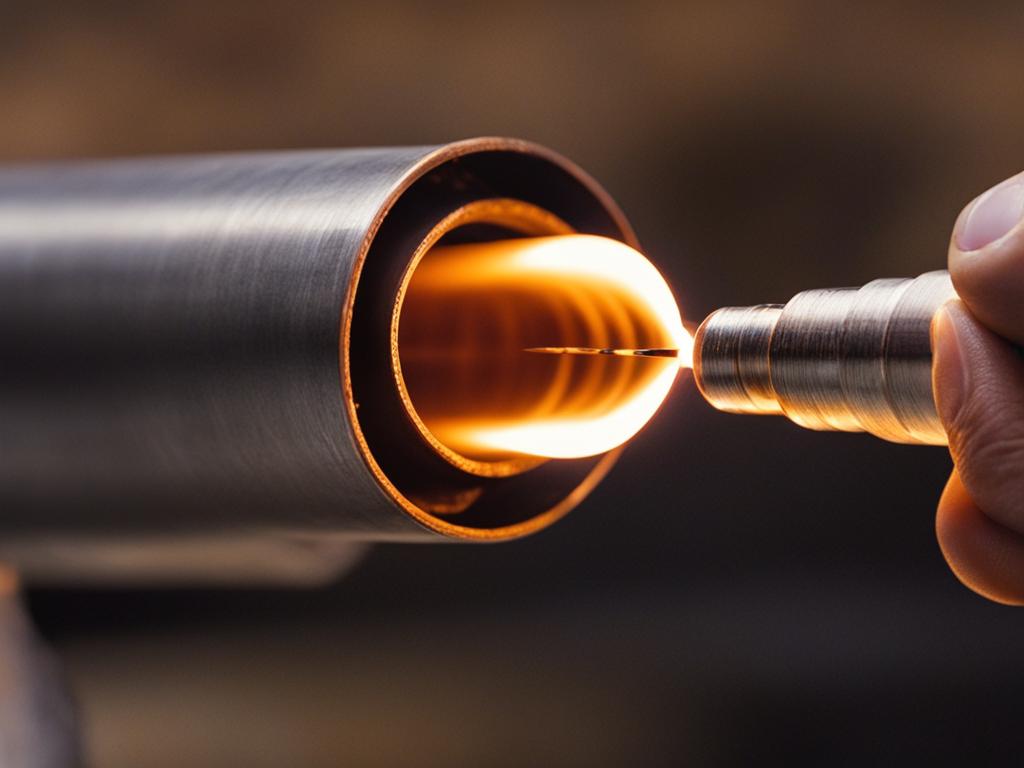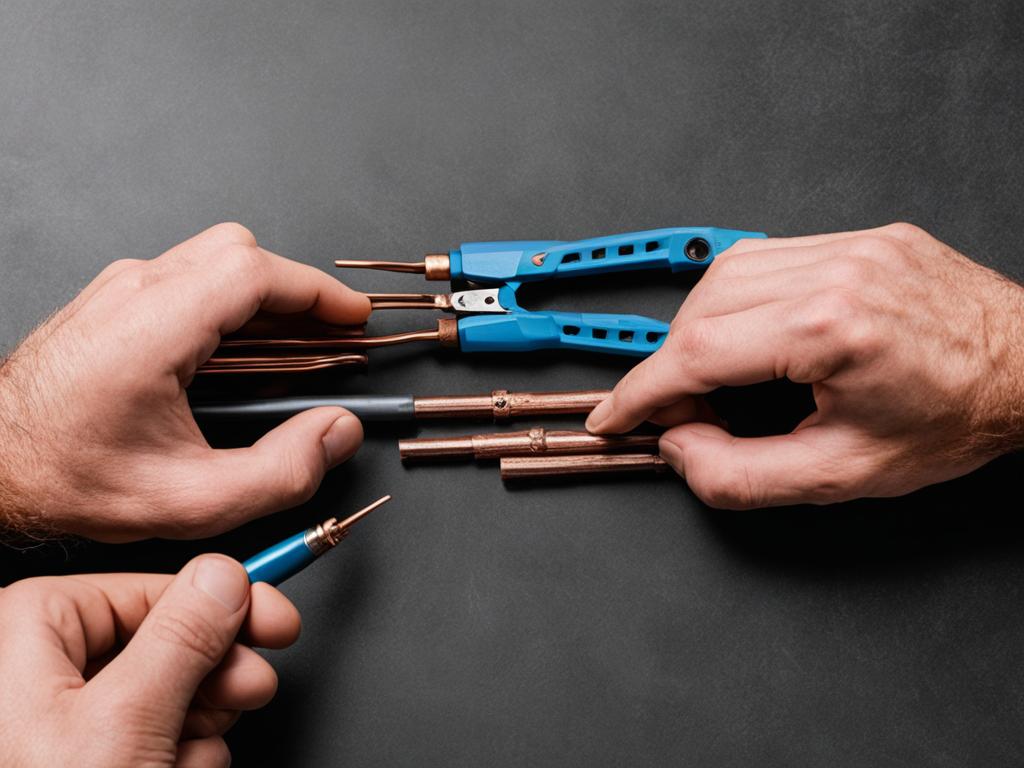When it comes to connecting copper pipes in plumbing, two popular methods emerge: crimping and soldering. While both techniques serve the same purpose, they differ in terms of process, benefits, and suitability for different applications. Understanding the key differences between copper pipe crimping and soldering is crucial for making the right choice for your plumbing needs.
Key Takeaways:
- Crimping and soldering are two common methods for connecting copper pipes in plumbing.
- Crimping involves using a crimping tool to create a secure and watertight connection, while soldering involves melting solder to join the pipes together.
- Crimping offers benefits such as quick installation, reliability, and safety, making it suitable for various applications.
- Soldering provides a seamless and durable connection but requires more skill and experience.
- The choice between crimping and soldering depends on factors like specific application, skill level, and personal preference.
Benefits of Crimping Copper Pipe
Crimping copper pipe offers several benefits. Firstly, it is a quick and efficient method of connecting pipes, saving time during installation. The crimped connections provide a secure and reliable joint that is resistant to leaks, ensuring the longevity of the plumbing system.
Unlike soldering, crimping does not require the use of heat, eliminating the risk of fire hazards and reducing the need for specialized tools. This makes crimping a safer option, especially for DIY enthusiasts and beginners who may not have extensive soldering experience.
Furthermore, crimping is a forgiving technique that does not demand the same level of skill and precision as soldering. It offers flexibility in accommodating various pipe sizes and can be easily mastered with minimal practice. This makes it an accessible option for both professionals and homeowners looking to tackle plumbing projects on their own.
The crimping method ensures a watertight seal and creates a strong connection between copper pipes. These crimped connections are known for their durability and reliability, providing peace of mind and reducing the likelihood of future repairs. The secure joints not only prevent leaks but also enhance the overall efficiency of the plumbing system.
When using the crimping method, it is essential to use high-quality crimping tools and reliable copper fittings to ensure optimal results. Proper installation technique and adherence to industry standards are crucial for achieving the full benefits of crimping copper pipe.
To summarize, the benefits of crimping copper pipe include:
- Quick and efficient installation
- Reliable and durable connections
- Safe and tool-friendly method
- Accessible for beginners
- Watertight seals and leak prevention
- Enhanced plumbing system efficiency

Advantages of Soldering Copper Pipe
Soldering copper pipe offers numerous benefits in plumbing. This method provides a seamless connection between pipes, ensuring a smooth and consistent flow of water. The soldered joints are known for their strength and durability, as the solder creates a strong and reliable bond between the pipes. Additionally, soldering is a versatile technique that can be used in various applications and can accommodate different pipe sizes.
One of the key advantages of soldering is its ability to create a leak-free connection. Soldering forms a tight seal between the pipes, minimizing the risk of leaks or water damage. This is particularly important in plumbing systems where water pressure is a concern.
Soldering creates a strong bond between copper pipes, ensuring a durable and long-lasting connection.
Another advantage of soldering is its versatility. This method can be used for a wide range of applications, from small home repairs to large-scale plumbing projects. It can accommodate different pipe sizes and shapes, making it a versatile choice for plumbers and DIY enthusiasts alike.
Please insert image here:

Comparative Analysis of Soldering and Crimping
When comparing soldering with crimping copper pipe, soldering offers several distinct advantages. While crimping is quick and efficient, soldering provides a stronger and more reliable connection. The soldered joints are less likely to loosen or deteriorate over time, ensuring a secure plumbing system.
Soldering also allows for easier repairs and modifications. Unlike crimped connections, soldered joints can be easily disassembled and re-soldered if necessary. This flexibility makes soldering an ideal choice for plumbing systems that may require future modifications or repairs.
Moreover, soldering does not require the use of additional fittings or connectors, reducing the risk of potential leak points. The solder forms a seamless bond between the pipes, resulting in a more efficient and leak-free plumbing system.
To summarize, the advantages of soldering copper pipe include:
- Seamless connection for a smooth flow of water
- Strong and durable joints
- Versatility for various applications and pipe sizes
- Leak-free plumbing system
- Easier repairs and modifications
- Reduced risk of potential leak points
Comparative Analysis of Soldering and Crimping
| Advantages | Soldering Copper Pipe | Crimping Copper Pipe |
|---|---|---|
| Strength and Durability | ✔ | ✔ |
| Flexibility for Repairs and Modifications | ✔ | ✘ |
| No Need for Additional Fittings | ✔ | ✘ |
| Potential Leak Points | Reduced | Higher |
Conclusion
After examining the benefits and advantages of copper pipe crimping and soldering, it is evident that both methods have their strengths and weaknesses. The decision on which method is better for connecting copper pipes ultimately depends on your specific needs and preferences.
Copper pipe crimping offers advantages such as quick installation, reliability, and safety. It is a popular choice among plumbers and DIYers due to its ability to create secure and watertight connections without the use of heat. Crimping is also more forgiving for beginners, as it does not require as much skill or experience as soldering.
On the other hand, soldering provides a seamless and durable connection between copper pipes. It creates a strong bond that ensures a smooth flow of water. Soldering is a versatile method that can be used in various plumbing applications and accommodates different pipe sizes. However, it does require more skill and experience to achieve proper and reliable connections.
When deciding between copper pipe crimping and soldering, be sure to consider factors such as the specific application, your skill level, and personal preference. Evaluate the requirements of your plumbing project and choose the method that best aligns with your needs. Both methods are effective, so it’s important to choose the one that you are most comfortable and confident in using.
FAQ
What is the difference between crimping and soldering copper pipes?
Crimping involves using a crimping tool to create a secure and watertight connection, while soldering involves melting a metal alloy (solder) to join the pipes together.
What are the benefits of crimping copper pipe?
Crimping offers benefits such as quick installation, reliability, durability, and safe connections without the need for heat. It is also more forgiving for beginners.
What are the advantages of soldering copper pipe?
Soldering creates seamless connections, resulting in smooth water flow. It also offers strength, longevity, versatility, and the ability to accommodate different pipe sizes.
When should I use crimping for copper pipes?
Crimping is a popular choice for many plumbers and DIYers due to its quick installation, reliability, and safety. It is ideal for various applications and suitable for all skill levels.
When should I use soldering for copper pipes?
Soldering is recommended when creating seamless connections, especially for applications that require a smooth flow of water. However, it requires a higher level of skill and experience.
